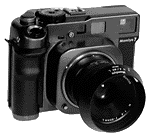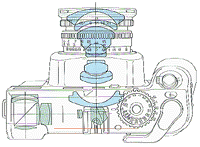At Last: A Medium Format Camera for the Mountain Environment
 The Mamiya 7 The Mamiya 7
Perched 200 feet above the deck on a frozen waterfall, I pulled an object foreign to vertical terrain from my chest pouch: a medium format camera. My partner climbed up a blue icicle. The little camera clicked softly as I shot. Unlike its bigger brethren, or even it's 35mm cousins, it didn't shudder as a mirror slammed open, and its weight didn't upend me. Its virtues were subtractive, consisting of sins uncommitted. The new Mamiya 7 rangefinder performed like a champ in the mountains.
|
||||||||||||||||||
| Camera designers juggle compromises. 8x10 yields the richest transparencies, but you can't cover a basketball game with one. An autofocus motor-driven 35 mm can track a wildebeest stampede, but a wall-sized print from the slide would resemble a painting by Seurrat. For my money, medium format delivers the best compromise. The size advantage over 35 mm catches the attention of photo editors. The gain in print quality is greater jumping from 35 mm to medium format than from 2 1/4 to 4x5. After years of lugging my Pentax 6x7 (measured in centimeters and equalling 2 1/4 by 2 3/4 inches) and its massive tripod over mountains and through rain forests, I needed relief. At times I felt as if my job description should read "beast of burden," not "photographer." The ravages of age and imprudence forced me to look for more lightweight equipment, but I was unwilling to give up the grainless images medium format affords. I turned to the Mamiya 7 6x7 rangefinder. As I adapted to a new way of shooting, I learned to understand why some people swear by rangefinders while others swear at them. First, rangefinders lack depth-of-field preview and through-the-lens metering. You figure critical focus with markings on each lens instead of looking through the lens. Also, the loss of TTL metering meant I would have to think when using filters instead of depending on the meter. Although painful, I prefer thinking to lugging excess weight.
The 7 features aperture priority exposure metering and exposure compensation two stops in either direction. LEDs in the viewfinder blink for establishing manual exposures. They also warn when the batteries are on their last legs and blink when over or under exposure threatens. Leaf shutter lenses yield several advantages over focal plane shutters found in most 35mm systems. The risk of camera shake caused by a mirror slamming open at the beginning of an exposure doesn't exist so one can dispense with the mirror lock up ritual. The tiny low-mass shutters cause almost no vibration during exposure so camera shake is less of a problem, and small, lightweight tripods suffice. Hand held shooting produces acceptably sharp images at slower speeds. The shutters are so quiet the least noise drowns them out. Scrapping the mirror shed weight and shrank the dimensions. The glory of the little Mamiya is its glass. I doubt that anything on the market exceeds their sharpness and freedom from aberrations. The four lenses include a 43mm F4.5 wide-angle, a 65mm F/4 wide-angle, an 80mm F/4 standard lens (actually a mild wide-angle), and 150mm F/4.5 short telephoto, equivalent to 71mm on a 35mm camera. Each comes with its own lens hood. The Mamiya 7 balances unsurpassed virtues against a number of inconveniences. It's the wrong camera for a Serengeti safari, true macro is beyond its ken, and addicts of auto-everything cameras may find withdrawal too distressing. I won't dispose of my other systems, but most days the little Mamiya will be my first choice. Whether I'm wandering the canyons of the Southwest or Manhattan, I can travel unencumbered without compromising on what matters most: the quality of the images.
|
|
|||||||||||||||||

 The Mamiya 7 tips the scales at svelte two pounds. It fits the hand well. The fingers of the right hand wrap snugly around a bulge, and the surface offers some friction for a secure grip.
The Mamiya 7 tips the scales at svelte two pounds. It fits the hand well. The fingers of the right hand wrap snugly around a bulge, and the surface offers some friction for a secure grip.